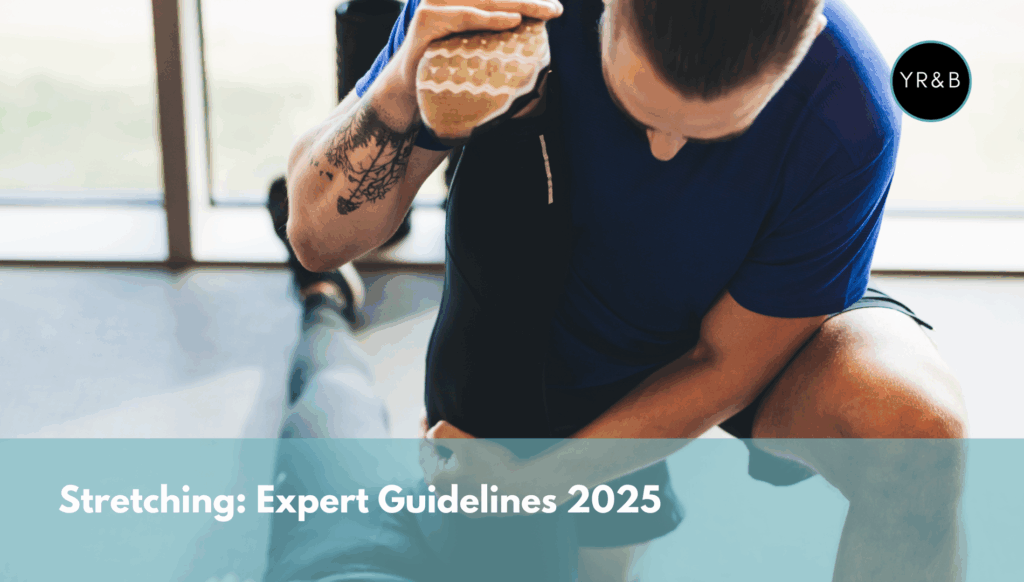What’s This Research About?
Stretching research is vast and sometimes contradictory. This paper aimed to unify terms and provide practical, evidence-based recommendations for coaches, clinicians, and exercisers. It did so by bringing together international experts to agree on definitions and to translate the best available evidence (largely from systematic reviews) into clear guidance for common goals: ROM, strength, hypertrophy, stiffness, injury risk, recovery, posture, and cardiovascular health.
This expert Delphi consensus gathers 20 leading stretching researchers to clarify what stretching does—and does not—do. The panel agrees that stretching (static, dynamic, and PNF) improves range of motion (ROM) acutely and over time, and that static stretching can reduce passive muscle-tendon stiffness when done at sufficiently high “dose.” They also judged that consistent static stretching may benefit vascular health, though evidence is still limited. In contrast, they do not recommend stretching as the primary way to build muscle size or strength, prevent injuries, improve posture, or speed up post-exercise recovery. The paper also standardizes definitions (static, dynamic, PNF) and offers practical dosing guidance for different goals.
Highlights
- Clear, consensus definitions for static, dynamic, and PNF stretching.
- Stretching increases ROM acutely (minutes) and chronically (weeks); static/PNF favored for chronic gains.
- Avoid prolonged (>60 s per muscle) static holds right before maximal strength/power efforts.
- To reduce stiffness, dose is high: ≥4 min per muscle (acute) and ≥4 min per muscle, 5×/wk for ≥3 weeks (chronic).
- Possible cardiovascular benefits from static stretching (acute and chronic), but evidence is early; suggested doses provided.
- Not recommended as primary strategies for: hypertrophy/strength, posture change, general injury prevention, or rapid post-exercise recovery.

TITLE: Practical Recommendations on Stretching Exercise: A Delphi Consensus Statement of International Research Experts
PUBLICATION: Journal of Sport and Health Science
DATE: June 2025
AUTHORS: Konstantin Warneke, Ewan Thomas, Anthony J. Blazevich, José Afonso, David G. Behm, Paulo H. Marchetti, Gabriel S. Trajano, Masatoshi Nakamura, Francisco Ayala, Stefano Longo, Nicolas Babault, Sandro R. Freitas, Pablo B. Costa, Andreas Konrad, Antoine Nordez, Arnold Nelson, Astrid Zech, Anthony D. Kay, Olyvia Donti, Jan Wilke
Range of motion (ROM): How far a joint can move.
Static stretching: Holding a position where you feel stretch/resistance without movement.
Dynamic stretching: Moving in and out of end-range without holding still (often rhythmic).
PNF stretching: Stretching that includes muscle contractions (e.g., contract–relax).
Passive stiffness: The resistance you feel when a relaxed limb is moved; less stiffness can feel “looser,” but isn’t always better for performance.
Delphi method: Anonymous expert survey process to reach agreement.
Endothelial function / arterial stiffness / HRV: Markers of blood vessel health and nervous-system balance affecting circulation and heart rhythm variability.
Passive muscle–tendon stiffness: how much a muscle or tendon resists being stretched when it is relaxed. This concept is about mechanics, not sensation. Less stiffness = the tissue lengthens more easily. More stiffness = the tissue resists elongation more strongly.

